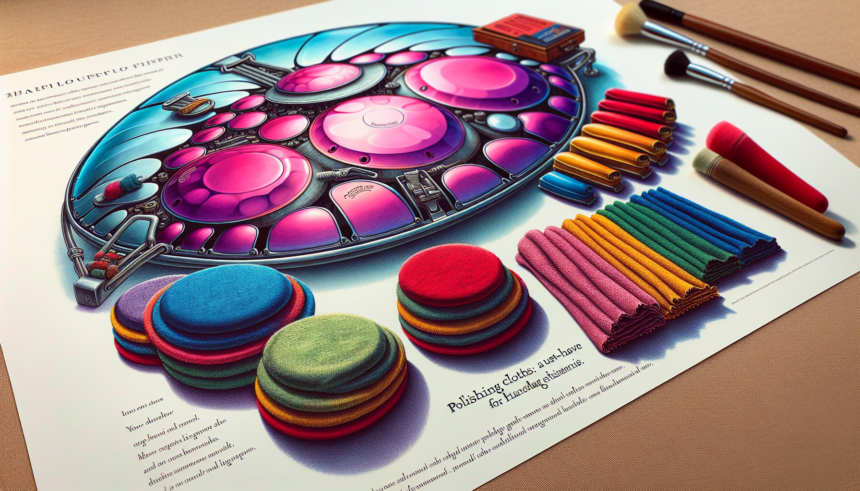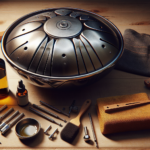Handpans, known for their mesmerizing sounds and ethereal aesthetics, have captivated music enthusiasts globally. However, owning a handpan comes with the responsibility of ensuring its longevity and maintaining its appearance. Enter polishing cloths, an essential tool for all handpan owners. These cloths are not merely for aesthetic preservation; they play a pivotal role in maintaining the instrument’s acoustic properties. This article delves into why polishing cloths are indispensable for handpan enthusiasts and offers insights on their effective use.
The Importance of Polishing Cloths
Handpans are typically crafted from nitrided steel, stainless steel, or other treated metals. These materials, while durable, are susceptible to dirt, oils, and fingerprints. Over time, such contaminants can tarnish the surface of the handpan, and worse, affect its sound quality. Polishing cloths are specifically designed to remove these contaminants without causing any damage to the instrument.
Unlike regular cloths, polishing cloths are made from microfibers or other gentle materials that do not scratch or harm the surface. They help in maintaining the shine and appearance of the handpan, ensuring that it remains as visually captivating as it is acoustically.
Types of Polishing Cloths
There are several types of polishing cloths available in the market, each catering to different needs and preferences:
- Microfiber Cloths: These are the most popular type of polishing cloths due to their effectiveness in capturing and removing particles without scratching the surface. They are highly absorbent and can be used dry or slightly damp.
- Silk Polishing Cloths: A bit on the luxurious side, silk polishing cloths are incredibly gentle and are ideal for delicate surfaces. They might not be as effective in removing heavy dirt but are perfect for final touches.
- Impregnated Cloths: These cloths come pre-treated with a polishing solution, making them a convenient option for quick maintenance. They can help in removing tarnish and adding a layer of protection to the handpan.
How to Use a Polishing Cloth on Your Handpan
Proper use of a polishing cloth is crucial to ensure the best results. Here’s a step-by-step guide on how to effectively clean your handpan:
- Preparation: Before you start, make sure your hands are clean and dry to avoid transferring oils onto the handpan. Place the handpan on a soft, stable surface.
- Dry Cleaning: Start by using a dry microfiber cloth to gently wipe the surface of the handpan. Use circular motions to pick up dust and light oils.
- Damp Cleaning: For more stubborn stains or fingerprints, lightly dampen a section of the microfiber cloth with water (avoid using harsh chemicals). Gently wipe the surface in circular motions.
- Final Polish: Use a dry section of the cloth to buff the handpan, restoring its shine and removing any remaining moisture or streaks.
- Storage: After cleaning, store your handpan in a dry, cool place to prevent any new contaminants from settling on its surface.
Benefits of Regular Maintenance
Regular maintenance of your handpan using polishing cloths offers a multitude of benefits:
- Extended Longevity: By regularly removing dirt and oils, you can prevent the formation of rust and other forms of corrosion, extending the life of your instrument.
- Enhanced Sound Quality: Clean surfaces contribute to clearer, more resonant tones, ensuring that your handpan consistently produces high-quality sounds.
- Aesthetic Appeal: A well-maintained handpan looks as beautiful as it sounds, with a pristine surface that reflects its craftsmanship.
- Investment Protection: Handpans are significant investments. Regular maintenance helps in preserving their value, ensuring that they remain in top condition over the years.
Choosing the Right Polishing Cloth for Your Handpan
Selecting the appropriate polishing cloth is essential for effective maintenance. Here are some factors to consider:
Material
The material of the cloth is paramount. Microfiber is highly recommended due to its balance of gentleness and effectiveness. Avoid coarse fabrics that could potentially scratch the handpan’s surface.
Size
The size of the cloth should be convenient for handling. A larger cloth can cover more surface area but should be easy to manage. Smaller cloths can be used for detailed cleaning.
Absorbency
Highly absorbent cloths are beneficial for dealing with moisture and oils. Microfiber cloths excel in this area, capturing and trapping particles within their fibers.
Reusability
Consider investing in reusable and washable cloths for sustainable maintenance. High-quality microfiber cloths can endure multiple washes while maintaining their effectiveness.
Brand Reputation
Brands with a proven track record in instrument care are generally a safe bet. Reviews and recommendations from other handpan enthusiasts can also guide your choice.
Alternative Cleaning Methods
While polishing cloths are the primary tool for handpan maintenance, there are alternative methods that can complement their use:
Silica Gel Packs
Place silica gel packs in your handpan storage case to absorb moisture, preventing rust and corrosion.
Protective Coatings
Some players apply a thin layer of oil (like sewing machine oil) to their handpans to create a protective barrier against moisture and dirt. Always use a polishing cloth to apply and remove excess oil.
Professional Cleaning
For extensive maintenance, consider professional cleaning services. Professionals can use specialized products and techniques to restore your handpan to its optimal condition.
Conclusion
In conclusion, polishing cloths are an essential asset for any handpan enthusiast. They ensure the longevity, sound quality, and visual appeal of these exquisite instruments. By investing in high-quality polishing cloths and incorporating them into a regular maintenance routine, handpan owners can enjoy their instruments at their best for years to come. The right cloth, paired with proper use, can make a significant difference in the upkeep of your handpan, safeguarding your investment and enhancing your musical experience.
Frequently Asked Questions (FAQs)
1. How often should I use a polishing cloth on my handpan?
The frequency depends on how often you play and the environment in which you store your handpan. Generally, a light cleaning after each use and a more thorough polish every few weeks is recommended.
2. Can I use regular household cleaners on my handpan?
It’s best to avoid harsh household cleaners as they can damage the coating and metal of the handpan. Stick to using water or specialized handpan cleaning solutions.
3. Is it necessary to use a damp cloth for cleaning my handpan?
Using a damp cloth can help remove stubborn spots and fingerprints. However, always ensure the cloth is only slightly damp and not wet to avoid water damage.
4. What should I do if my handpan develops rust?
If you notice rust, consider using a fine abrasive cloth specifically designed for metal to gently remove it. Follow up with a polishing cloth and apply a thin layer of protective oil.
5. Do polishing cloths leave any residue on the handpan?
High-quality microfiber polishing cloths should not leave any residue. Ensure the cloth is clean and free from any particles before use.





